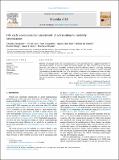Life cycle environmental assessment of a transition to mobility servitization
Author(s)
Weigl, Dustin
DownloadPublished version (1.071Mb)
Publisher with Creative Commons License
Publisher with Creative Commons License
Creative Commons Attribution
Terms of use
Metadata
Show full item recordAbstract
Mobility servitization modes are increasingly popular and some literature has suggested that their environmental impacts are less than those of privately owned cars. This research assesses the greenhouse gas (GHG) emissions of mobility servitization based on different scenarios: carsharing, carpooling and car ownership (representing the range of occupancy rates), and the changes in vehicle technology (lightweighting and electrification). Life Cycle Assessment is selected as the method and results are interpreted in passenger kilometre. The highest GHG reduction is recorded in pooled adoption scenario, representing the highest occupancy rate in servitization modes. The increasing trends of vehicle lightweighting and electrification can potentially reduce the GHG impacts (during production and use phases) by 35-37%.
Date issued
2020-08Department
Sloan School of ManagementJournal
Procedia CIRP
Publisher
Elsevier BV
Citation
Fernando, Chalaka et al. “Life cycle environmental assessment of a transition to mobility servitization.” Procedia CIRP, 90 (August 2020): 238-243 © 2020 The Author(s)
Version: Final published version
ISSN
2212-8271